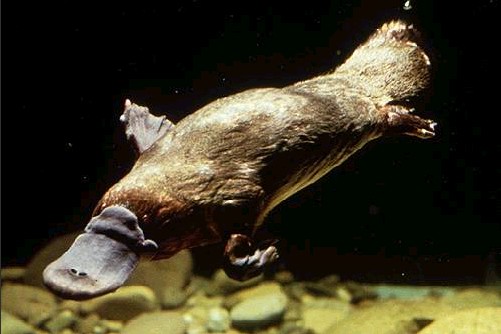![]()
Confusión en el párrafo centésimo quincuagésimo segundo párrafo de El Origen de las Especies

¿Ha estado sometido el Ornitorrinco a competición menos severa? O al contrario, ¿sobrevive precisamente por haber sido capaz de soportar competición más severa o igual de severa? ¿Existe algún modo de medir el nivel de competición?
Dice este párrafo:
the fact of the productions of the smaller continent of Australia now yielding before those of the larger Europaeo-Asiatic area.
el hecho de que las producciones del pequeño continente australiano cedan ante las del gran territorio europeo asiático
¿A qué producciones se refiere?
Y cuándo dice:
….. forms now known in the world, as the Ornithorhynchus and Lepidosiren, which, like fossils, connect to a certain extent orders at present widely separated in the natural scale.
¿Qué quiere decir con connect to a certain extent orders at present widely separated? ¿A qué órdenes se refiere?
152.
In accordance with this view, we can, perhaps, understand some facts which will be again alluded to in our chapter on Geographical Distribution; for instance, the fact of the productions of the smaller continent of Australia now yielding before those of the larger Europaeo-Asiatic area. Thus, also, it is that continental productions have everywhere become so largely naturalised on islands. On a small island, the race for life will have been less severe, and there will have been less modification and less extermination. Hence, we can understand how it is that the flora of Madeira, according to Oswald Heer, resembles to a certain extent the extinct tertiary flora of Europe. All fresh water basins, taken together, make a small area compared with that of the sea or of the land. Consequently, the competition between fresh water productions will have been less severe than elsewhere; new forms will have been more slowly produced, and old forms more slowly exterminated. And it is in fresh water basins that we find seven genera of Ganoid fishes, remnants of a once preponderant order: and in fresh water we find some of the most anomalous forms now known in the world, as the Ornithorhynchus and Lepidosiren, which, like fossils, connect to a certain extent orders at present widely separated in the natural scale. These anomalous forms may be called living fossils; they have endured to the present day, from having inhabited a confined area, and from having been exposed to less varied, and therefore less severe, competition.
De conformidad con esta opinión, podemos quizá comprender algunos hechos, sobre los que insistiremos de nuevo en nuestro capítulo sobre distribución geográfica; por ejemplo: el hecho de que las producciones del pequeño continente australiano cedan ante las del gran territorio europeo asiático. Así también ha ocurrido que las producciones continentales en todas partes se han llegado a naturalizar en tan gran número en las islas. En una isla pequeña, la lucha por la vida habrá sido menos severa, y habrá habido menos modificación y menos exterminio. Por esto podemos comprender cómo la flora de Madeira, según Oswal Heer, se parece, hasta cierto punto, a la extinguida flora terciaria de Europa. Todas las masas de agua dulce, tomadas juntas, constituyen una extensión pequeña, comparada con la del mar o con la de la tierra. Por consiguiente, la competencia entre las producciones de agua dulce habrá sido menos dura que en parte alguna; las nuevas formas se habrán producido, por consiguiente, con más lentitud y las formas viejas habrán sido más lentamente exterminadas. Y es precisamente en las aguas dulces donde encontramos siete géneros de peces ganoideos, resto de un orden preponderante en otro tiempo, y en agua dulce encontramos algunas de las formas más anómalas conocidas hoy en el mundo, como Ornithorhynchus y Lepidosiren, que, como los fósiles, unen, hasta cierto punto, órdenes actualmente muy separados en la escala natural. Estas formas anómalas pueden ser llamadas fósiles vivientes: han resistido hasta hoy por haber vivido en las regiones confinadas y por haber estado expuestos a competencia menos variada y, por consiguiente, menos severa.
